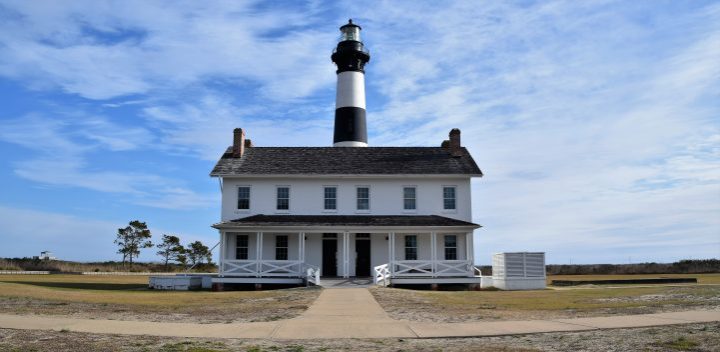National parks on the North Carolina coast are some of the most threatened by rising seas in the nation, but in the context of wildfires, droughts, invasive species and excessive rain events plaguing the parks in the interior states, coastal woes are hardly the only problem the National Park Service is facing from climate change.
“The issue is challenging us like we’ve never been challenged before,” said Cat Hawkins Hoffman, the agency’s national adaptation coordinator, Climate Change Response Program.
Supporter Spotlight
“We have a whole bunch of historic structures that are highly vulnerable.”
Dave Hallac, Superintendent National Parks of Eastern North Carolina
A report the program released in May projected sea level rise for 118 park units and storm surge projections for 79 of those parks. Of those studied, the parks in the Southeast region, which includes North Carolina, were projected to be at risk of the highest storm surges. The Outer Banks parks were projected to experience the highest sea level rise by 2100.
But park managers at Cape Lookout and Cape Hatteras national seashores have already taken steps to protect their parks from future impacts.
“This confirms to me that we ought to be paying a lot of attention to sea level rise,” said Dave Hallac, superintendent of National Parks of Eastern North Carolina. “The first thing we have done, even in advance of this report, we needed site-specific information. … We have a whole bunch of historic structures that are highly vulnerable.”
Curiously, the shoreline near Wright Brothers National Memorial in Kill Devil Hills was named as the park threatened by the highest projected sea level rise. But of all the Outer Banks parks, it is the highest and driest. That is because the projection looked at the level of rising water, but did not look at local topography.
Hallac said it explains why park managers need to also tap all available data to understand how the local landscape will respond to storm surge and higher seas. To that end, a separate report done by Tom Allen, a geography professor and researcher at Old Dominion University, looked specifically at elevations and other details of historic buildings in Cape Hatteras National Seashore to help the park determine mitigation and proactive management strategies to protect resources.
Supporter Spotlight
“We learned that Bodie Island Lighthouse keepers’ quarters is one of the most threatened structures,” Hallac said. “That helps us prioritize.”
Similar studies have also been done to look at protection of cultural resources in Portsmouth Village and at the lighthouse village at Cape Lookout National Seashore.
Although sea level rise is an obvious stressor the park system has to address, Hawkins Hoffman said, the report – compiled mostly from National Oceanic and Atmospheric Administration, GIS and the 2013 Intergovernmental Panel on Climate Change (IPCC) data – can help managers assess the threat to their parks. More than a quarter of park units – and their resources – are in coastal regions, she added.
“That helps us hone, even more to focus, our efforts on areas that have the most exposure,” Hawkins Hoffman said in a recent interview. “This is high-level view that simply identifies where exposure is higher.”
Initially entangled in controversy about references to human factors in climate change, the final report does not dance around the accepted science behind the issue. Despite doubts about climate change expressed by some in the current administration, she said the National Park Service, where she has worked for 37 years, has not been obstructive and is moving forward to address the effects of climate change.
“We’re working with all the parks,” she said. “This administration does not have the same approach as the last administration, and that is life. Regardless of the approach, this issue is not going away. It is something we’ll be dealing with for decades, even centuries.”
Considering that cultural resources in 415 park units number in the tens of thousands, ranging from archaeological sites at Jamestown to the Statue of Liberty to the Cape Hatteras Lighthouse, all situated in locations under various levels of vulnerability exacerbated by climate change – wildfires, melting permafrost, flooding, insect infestation, algal blooms, intense storms, shoreline erosion, saltwater intrusion – the complexity of their protection can be overwhelming to contemplate.
Not to mention that the agency is also the designated steward of cultural resources through numerous programs including the National Register of Historic Places, the National Historic Landmark Program and American Battlefield Protection Program, among others.
“We are certainly aware of issues in the coastal zone,” said Marcy Rockman, climate change coordinator for cultural resources. “But then I am also very concerned and have been for some time with what is happening with the interior of the country.”
Rockman said there are about 95,000 archaeological sites, thousands of historic structures and hundreds of cultural landscapes – a combination of built and natural environments – identified nationally.
Rockman, currently the sole staff member overseeing cultural resources among the 15 or so staff in the agency’s Climate Change Response Program, said that the program is working with local park managers and academic and community partners to develop vulnerability assessments and a list of priorities for each park.
“I like to think about it as a big family, and all the kids need new shoes,” Rockman said. “We try to figure out which kid needs shoes first, and what type of shoe.”
The first pilot program is close to being completed at Cape Lookout, she said, and the goal is to tweak the model so it can utilized nationwide as a tool for park managers.
Coastal Review Online reached out to Cape Lookout Superintendent Jeff West, but he was on leave and could not be reached for comment.
Many park assets are experiencing threats, Rockman said, but determining which are most threatened is challenging because documentation is lacking to track changes.
How fast are changes happening? How is it changing? Is it moldy, crumbling, flooded, cracking? Sometimes changes are happening, but it takes a while to notice. For instance, one park’s annual lilac festival no longer coincided with the blooming of the lilacs.
Western Carolina University in Cullowhee is working with the park service on assessing vulnerability of park facilities, Rockman said. Subsequent studies are also planned to look at vulnerabilities of natural resources and cultural resources.
Even as debate is ongoing on what measures to take, when to take them and how to pay for them, Hawkins-Hoffman said the park service is working to coordinate the best approach to protect its resources in the future.
“We all need to be aware of the magnitude of this issue,” she said. “It’s so critical to be pulling together in a way that focuses on what people are experiencing, so we can work together on this issue as a community.”











